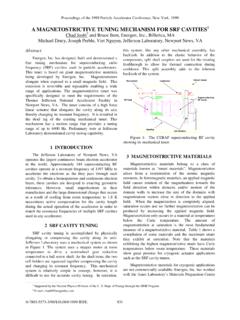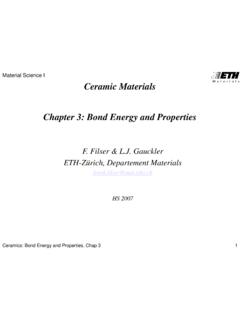Transcription of Ion Implantation for Semiconductor Devices: The Largest ...
1 WEYB2 Proceedings of PAC2013, Pasadena, CA USA. ION Implantation FOR Semiconductor DEVICES: THE Largest . USE OF INDUSTRIAL ACCELERATORS. Felch, Susan Felch Consulting, Los Altos Hills, CA 94022, USA. Current, Current Scientific, San Jose, CA 95124, USA. Taylor, Taylor Consulting, Lake Oswego, OR 97034, USA. Abstract show large fluctuations due to the highly cyclic nature of Ion acceleration of dopants and other ions is a critical IC fab construction trends, especially when driven by and nearly universally employed tool for the fabrication additional factors, such as shifts in dominant wafer sizes, of transistors in Semiconductor devices and the various introduction of new implanter machine types and IC.
2 Forms of electronic, photovoltaic and photonic materials. devices, expansion into new global regions, and variations This paper reviews the major types of accelerators, ion driven by general economic cycles. The combination of sources, and scanning methods used in contemporary these technology and market factors has resulted in a practice for ion Implantation for electronic applications. rather steady 5-year cycle in units sold per year over the last 3 decades. INTRODUCTION. The use of accelerated ions to dope and modify Semiconductor materials, generally called ion Implantation , is a core technology for the fabrication of integrated circuits (IC), which form the backbone of the global communications and advanced computation capabilities that have transformed modern life over the last half-century.
3 The use of ion implanters in the IC. industry, starting in the 1970s for precision doping of channel structures at doping densities of ~10 4. monolayers to set the threshold conditions for transistor switching, enabled the practical fabrication of Figure 1: Estimates of the number of commercial ion complementary metal-oxide- Semiconductor (CMOS) implanters sold per year, mainly for IC fabrication. The transistors that are now the dominant form of IC devices. data shown here are an underestimate, particularly for the Development of accelerator technologies capable of earlier years.
4 Delivering highly stable and collimated ion beam currents, ranging from a few A to 100 mA, and incident ion energies, ranging from 100 eV to ~10 MeV, have provided a broad and capable technology for fabrication Semiconductor APPLICATIONS OF. of ICs for logic, memory, and analog operations, as well ION Implantation . as an increasingly varied array of optical sensors and The planar CMOS transistor, illustrated in Fig. 2, has imaging devices. Ion Implantation is now used for the been the workhorse device structure for IC devices for overwhelming majority of applications for doping of Copyright c 2013 and by the respective authors logic and memory applications since the mid-1980s.
5 Semiconductor materials and in an increasing array of applications for creation and modification of electronic and photonic materials. The yearly revenues from the sale of industrial ion Implantation and materials modification tools are a US$ market (in normal economic environments). In addition, there are substantial markets for suppliers of dopant species materials (~US$140M/year) and a diverse array of suppliers of spare and upgrade parts and services. Additional parts of the ion Implantation commercial infrastructure include the suppliers of system components, magnets, power supplies, and vacuum pumps, and a varied array of metrology tools focused on process characterization and control applications.
6 Figure 2: Sketch of major doped regions for a planar The average number of commercial ion Implantation CMOS transistor. systems sold per year, predominantly for fabrication of Si- based IC devices, has increased from ~250 to ~400 per For doping of near-surface (<100 nm) layers on Si with year since 1980, as seen in Fig. 1. The year-to-year sales the common dopants B, As, and P, the beam energy ISBN 978-3-95450-138-0 09 Industrial Accelerators and Applications 740 U02 - Materials Processing and Modification Proceedings of PAC2013, Pasadena, CA USA WEYB2. requirement for atomic species is a fraction of a keV to a High energy ion energies above 200 keV and up few tens of keV.
7 Increasingly, the ion species of choice to 10 MeV. for low energy (sub-keV) implants is some form of Very high dose efficient implant of doses greater molecular ion containing up to 18 dopant atoms (for than 1016 ions/cm2. B18H22), allowing for beamline operation at proportionally higher energies and significantly higher total beam flux for higher production throughputs. For deeper profiles to form CMOS wells for transistors and optical imagers, ion energies range up to several MeV. The initial applications for ion Implantation were for low dose (1011 to 1012 ions/cm2) doping of CMOS.
8 Channels to set the transistor switching, or threshold , conditions. These implants required relatively modest beam currents, with 100 to 500 A being common for medium-current implanters. By 1980, higher current sources and beamlines were developed for high-current . machines, to produce beams of 1 to 30 mA of dopant ions. These machines were capable of efficient implants with Figure 3: Dose and atom energy regions for CMOS. doses of ~5x1015 ions/cm2 used for CMOS source/drain transistor doping (gold), high dose hydrogen implants for junctions, as well as emitter, buried layer, and collector Si layer splitting (lavender), and direct Implantation of implants for bipolar devices.
9 Oxygen to form Silicon-on-Insulator (SOI) wafers (green). By the late 1980s, Implantation machines capable of ion energies of ~1-2 MeV were being used for doping deep retrograde wells in CMOS devices, to suppress latch-up Accelerator systems for ion Implantation are provided instabilities between neighboring well structures and to commercially by a number of vendors, with the business reduce radiation-generated soft failures in Dynamic being dominated by a few long-standing companies: Random-Access Memory (DRAM) arrays. With the Applied Materials/Varian Semiconductor Equipment evolution of complex doping schemes to suppress lateral (Gloucester, MA), the market leader; Nissin Ion punch-through between source and drain junctions in Equipment (Kyoto, Japan), with a strong Asian market short channel (<100 nm) transistors, ion implanters were position; Advanced Ion Beam Technology (Hsinchu, developed with capabilities for mid-1014 ions/cm2 doping Taiwan), a new high-current vendor.
10 Axcelis at beam incidence angles up to 45 , to provide additional Technologies (Danvers, MA), leading the high-energy well doping in a halo surrounding shallow source-drain market; and SEN Corporation (Shikoku, Japan), former extension (SDE) junctions. Axcelis partner also with a strong Asian market presence. The CMOS transistors of the current decade are three- Other smaller vendors include Ion Beam Services dimensional structures, called FinFETs or tri-gate (Rousset, France), a new Plasma Immersion Ion transistors. The majority of implants for these devices Implantation (PIII) and SiC implanter company; Ulvac continue to be the same, with over 40 implant steps per Technologies (Japan), long-time vendor for research and device for doping and materials modification applications.






